Abstract
In the digital age, virtual simulation images have become an important communication form of Chinese traditional Yue Opera costumes and their culture. Focusing on the lay viewers’ aesthetic experience, we collected 16 subjective evaluations, including favorites of basic design elements, semantic impressions, and high-level aesthetic experience, of 257 participants on 5 virtual simulation pictures of Yue Opera costumes for different characters and used network analysis to explore the possible relationship of the variables. The inferred networks showed that the archetypal aesthetic was more relevant to the costume design elements, emotions, interests, and the sense of high level. The conspicuous clothing, understanding of creative intent, and the desire for cultural knowledge were key “bridges” in the aesthetic process. Although the aesthetic network of each costume varied partially based on character differences, it showed more similarities overall. On the basis of the findings, we discuss the possible theoretical basis of the networks and make practical suggestions for the virtual dissemination of Yue Opera costumes.
1 Introduction
Yue Opera, the second-largest form of drama in China, holds significant cultural and historical value. Its costume production skills have been recognized and included in China’s Intangible Cultural Heritage protection list, serving as a part of the diverse theatrical art forms. In recent years, virtual simulation technology has played a crucial role in preserving and promoting cultural heritage. Virtual simulation transforms two-dimensional images into three-dimensional virtual garments, enabling the virtual replication and restoration of Yue Opera costumes. Scholars have increasingly explored the application of digital technology to the preservation and protection of Yue Opera costumes [1]. This advancement also expands the avenues for disseminating Yue Opera costumes, allowing people to observe traditional attire in greater detail. Furthermore, the incorporation of traditional clothing and cultural elements in modern fashion design, blending culture, art, and modern technology injects new vitality and creativity into contemporary fashion. However, amidst the growing importance of Yue Opera costume virtual simulation technology, there is a basic but crucial question demanding attention and resolution: What are the public’s perception and aesthetic preferences of these virtual simulated traditional opera costumes?
Fortunately, the field of aesthetic cognition research provides a robust foundation for addressing these inquiries. Cognitive aesthetic research has a history spanning over a century, tracing its roots back to the experimental aesthetics pioneered by the renowned German psychologist Fechner in the nineteenth century [2]. Subsequently, through the works of Hodin and Valentine [3], Zeki [4], Jacobsen [5], Leder et al. [6], Silvia [7], Jacobs [8], Burke [9], and others, the study of aesthetic cognitive psychology has evolved into a relatively comprehensive and systematic research field. Current aesthetic research focuses on painting [10], photography [11], dance [12], music [13], literature [8], and other fields, mainly studying audience’s aesthetic cognitive process and cognitive model.
Based on the development of aesthetic cognition theory, the research in the field of aesthetic cognition of clothing has also achieved fruitful results. For example, Kodžoman et al. [14] studied the visual texture perception mechanism of fabrics through semantic evaluation, and Li et al. [15] studied the styling style cognition of suits based on the image scale method. Wei and Liu [16] explored the factors affecting the attention of distorted parallax clothing images based on eye movement experiments and perceptual evaluation scales. Chen et al. [17] studied users’ emotions toward images of one-piece swimsuits with different structures based on the pleasure–arousal–dominance three-dimensional emotional model. Taking the color design of men’s plain-color shirts as an example in China, Ge et al. [18] established an online clothing color preference recommendation algorithm model for group consumers based on Kansei Engineering. These studies have practical significance for improving different types of clothing design. However, on the one hand, these studies lack attention to the digital simulation images of Yue opera costumes. On the other hand, the research paradigms often focus on a single dimension of aesthetic cognition, such as aesthetic emotion or perceptual evaluation, without taking into account the interaction between aesthetic cognition elements.
The study of the aesthetic process has been paid more attention by many researchers. In 2021, Specker et al. [19] proposed the aesthetic effect network (AEN), innovatively using network analysis methods to study the aesthetic process. Network analysis emphasizes the multidimensional relationship between the variables quantitatively, helping scrutinize the interactions involved in the process of aesthetic cognition. In the network, manipulating an influential node may affect multiple related variables of other nodes. Thus, it has more potential to help address and discuss the relationship between aesthetic variables in the digital simulation of Yue Opera costumes.
However, due to the particularity of Yue opera costumes, AEN’s model cannot be simply copied in its entirety. This is because AEN uses abstract paintings as examples, leverages relatively ambiguous word pairs as the scales, and is not very applicable to the actual aesthetic design guidance of Yue Opera costumes. Compared with paintings, the visual representation of Yue Opera costumes has relatively fixed formulas and themes. Therefore, we combined the design features of Yue Opera costume simulation images on the basis of AEN to measure the audience’s feelings about its underlying design elements, semantic features, and high-level aesthetic experience, forming a measurement collection in which concrete and abstract variables coexist, allowing the network model to be more systematic. If we can describe the potential relationships of these variables and infer the critical nodes in the network, practical guidance may be provided according to the results.
To summarize, this study utilizes the research work of aesthetic cognition as a foundation and employs the network analysis to examine the contextualized aesthetic effects regarding virtual simulation images of Yue Opera costumes. This article is expected to theoretically expand the scope of network analysis by exploring its potential within the realm of aesthetic cognition of Yue Opera costume simulation images and provide a reference for the digital design and dissemination of Chinese Yue Opera costumes in practice.
2 A brief review: The development of Yue Opera costume and its virtual simulation
Yue Opera, originated in Shengzhou, Zhejiang, China, in the mid to late nineteenth century, is a lyrical local opera that evolved from the local “rap” art form [20]. Comprising local folk songs and Buddhist songs, Yue Opera was initially sung by farmers while working. In 1917, a significant number of Yue Opera artists migrated to Shanghai, China, presenting their performances on stage and causing a great sensation. This led to the gradual rise of Yue Opera as the second-largest opera in China.
In Yue Opera performances, various roles are depicted, including Huadan (young females), Shusheng (young males), Zhengdan (primarily middle-aged females), Laosheng (senior males), Laodan (elderly females), Wusheng (young and middle-aged male martial artists), clowns (often portraying comedic characters with painted faces), and big faces (often portraying deceitful ministers, bullies, etc.). Each character in Yue Opera adorns distinct costumes representing different identities, statuses, and personalities. For instance, Zhengdan typically wears plain attire to convey composure, while Huadan’s costumes feature vibrant colors and embellishments, symbolizing the liveliness and splendor of young girls [21]. Yue Opera costumes effectively convey information about the characters’ circumstances and their development throughout the narrative.
Regarding costume design, Yue Opera broke away from the traditional Chinese opera’s constraints of the “upper five colors” (red, bright yellow, old green, black, and white) and “lower five colors” (purple, pink, sapphire blue, lake color, and fragrance color), incorporating a wide range of intermediate colors such as light blue, light yellow, and light green [22]. The costumes reflect the regional style of Jiangnan, China, embodying elegance, beauty, and softness [23]. Common styles and silhouettes of Yue opera costumes include skirts, pleats, paired collars, and arrow garments [24]. To enhance the performance of the stage, sleeves and silk are often used as decorations [25]. Most Yue Opera costumes have a “cross-plane structure,” which is the basic structural form of traditional Chinese national costumes [26]. Yue Opera costume patterns absorb the essence of traditional patterns in art forms such as painting and architecture and are organically combined with the styles, colors, and embroidery to express extremely rich content, including plant patterns, animal patterns, and human figure patterns. The smooth lines of the patterns, the ingenious combination, and the gorgeous colors shape the external image of the characters, expressing their inner world expressively and lyrically [27].
In the era of information technology, traditional art forms such as Yue Opera face challenges in maintaining relevance and engaging modern audiences. The conventional presentation methods and stylized costume designs of Yue Opera struggle to leave a lasting impression. Fortunately, virtual simulation technology has made significant advancements in the preservation and inheritance of traditional attire [28,29,30]. To safeguard its unique cultural value, Yue Opera needs to explore new modes of display and interpretation [22]. Therefore, it is necessary to study the audience’s aesthetic cognition to promote the iterative improvement of virtual simulation design and at the same time promote the cultural inheritance behind it.
3 Basis of theory and method
3.1 Aesthetic cognitive and its empirical study
The field of aesthetic cognitive psychology has experienced significant advancements. Leder et al. [6] proposed the renowned Model of Aesthetic Appreciation and Aesthetic Judgment. This model aims to elucidate why individuals are attracted to artworks and explore how aesthetic cognitive processing elicits aesthetic emotions and overall positive and self-rewarding aesthetic experiences. According to the model, aesthetic appreciation and judgment encompass five distinct stages: perceptual analysis, implicit memory integration, explicit memory integration, cognitive mastery, and evaluation. The outcome of aesthetic processing includes aesthetic emotions and aesthetic judgments. Thus, the cognitive mastery and evaluation stages of aesthetic appreciation and judgment establish a feedback loop [31]. For the visual art, Chatterjee proposed an overall framework of the neural basis of visual aesthetics [32]. This framework emphasizes the transition from spontaneous to self-aware evaluation. In 2014, Chatterjee also proposed the aesthetic triad structure. He believed that aesthetic experience includes the emotions, evaluations, and behaviors caused by these things, as well as the processes that constitute their interpretation and products [33].
Empirical research on aesthetic cognitive experience primarily focuses on the public’s aesthetic evaluation of specific artworks [34]. In the quantitative research on aesthetic cognitive experience, except for the eye-tracking experiments [10,34], domain-specific aesthetic scales have been created. For instance, some studies have utilized semantic bipolar scales based on Osgood et al.’s EPA model (EPA represents three dimensions of semantic evaluation: Evaluation, Potency, and Activity) [35]. The Survey for the Assessment of Aesthetic Perception (SAAP), proposed by Rowold in 2008, includes 16 factors encompassing emotion, cognition, and self-consistency. However, the SAAP does not fully cover the affective and cognitive processes related to beauty [36]. Hager et al. [37] introduced the Art Reception Survey Scale (ARS) in 2012, which utilizes a five-level Likert scale and consists of six factors: cognitive stimulation, negative emotion, professional knowledge, self-reference, artistic quality, and positive attractiveness, comprising a total of 30 items. This questionnaire has been tested and applied extensively. There are also the Aesthetic Emotion Scale developed by Schindler et al. [38] and the Aesthetic Experience Questionnaire (AEQ) developed by Wanzer et al. [39]. These studies provide references for scale development in this study.
3.2 Network analysis and its applications in psychology
Network analysis originated in the 1930s and began to be applied mainly in sociology [40]. With the increasing emphasis on the influence of social situations in psychological research [41,42], network analysis methods have been applied to the psychological research. The most widely used fields of this method are clinical psychology, psychometrics, and personality research. For example, psychiatric research attempted to use network models to understand and predict the dynamics of psychopathology [43,44,45]. Epskamp et al. [46] introduced the network model as a formal psychometric model, conceptualizing the covariance between psychometric indicators as resulting from pairwise interactions between observable variables in a network structure. Costantini et al. [47] analyzed individual differences (e.g., in personality and psychopathology) and their patterns of stability and variability via network analysis.
Recently, Specker et al. [19] introduced network models to explore the aesthetic domain, offering new perspectives on conceptualizing aesthetic experience. They proposed an AEN, which highlights the direct relationships and mutual influence between aesthetic effects. Drawing upon network communication theory [48,49], Specker et al. constructed a statistical network to model associative processes between aesthetic effects. In this network, nodes represent experiences of aesthetic perception, and edges represent connections between these nodes. Empirical experiments conducted with abstract artworks confirmed their hypothesis and validated the AEN model to a certain extent. Importantly, these findings did not invalidate the results of the EPA model but rather served as a complementary addition to the previous research. The psychological network changes from representing observations to quantitative nodes (e.g., mood states, symptoms, or attitudes) and connections representing statistical relationships, and can be passed to calculate the centrality index of the node and the weight of the link to evaluate each variable interrelationship [50,51].
In a psychological network, partial correlation coefficients are commonly used to assess the connections between nodes. The Least Absolute Shrinkage and Selection Operator regularization algorithm [52] was often chosen to exclude sampling errors in the network [53]. During network visualization, the width of the line and the saturation of the color directly reflect the magnitude of the bias correlation coefficient: the wider the line and the more saturated the color, the larger the bias correlation coefficient [54]. The centrality of a node reflects the position of the node in the network, and it is common to use node strength, closeness, betweenness, and expected influence as four indicators to reflect the size of the centrality of a node. Some scholars are convinced that for psychological networks, betweenness and closeness centrality seem to be particularly unsuitable as measures of node importance [55]. As an alternative, the expected influence is the sum of all edge values connected to a particular node, indicating that the point is more important in the network [56].
In this study, the network analysis was exploratively applied to investigate the aesthetic experiences associated with Yue Opera costumes. Network research helps to reflect patterns of coexistence between variables of interest to the researchers. In addition, finding influential nodes and manipulating them help to practically improve the nodes associated with them throughout the network.
4 Methods
4.1 Stimuli
To investigate audience’s aesthetic preferences and perceptions of Yue Opera costume virtual simulation images, five images representing common traditional Yue Opera costumes were created using clo3D 7.0. These images were based on the virtual simulation methods for Yue Opera costumes as described by Liu et al. [1] and Han [22]. We utilized 2D virtual images instead of direct 3D models. 2D virtual simulation images are the representations of a specific viewpoint of the 3D virtual models. We did not let the subjects directly interact with the models because their attention might be drawn to various interactive forms, which could potentially impact their aesthetic appreciation of the costumes themselves. In addition, 2D virtual simulation images have advantages over photos of actual costumes in terms of highlighting detailed features, offering control over lighting and background settings, and ensure consistency in experimental conditions. The costumes depicted five different roles: Huadan, Shusheng, Laosheng, Zhengdan, and Wusheng. Each material had a resolution of 1,752 × 1,023 pixels, presenting the costumes from the front and back perspectives (as illustrated in Figure 1).
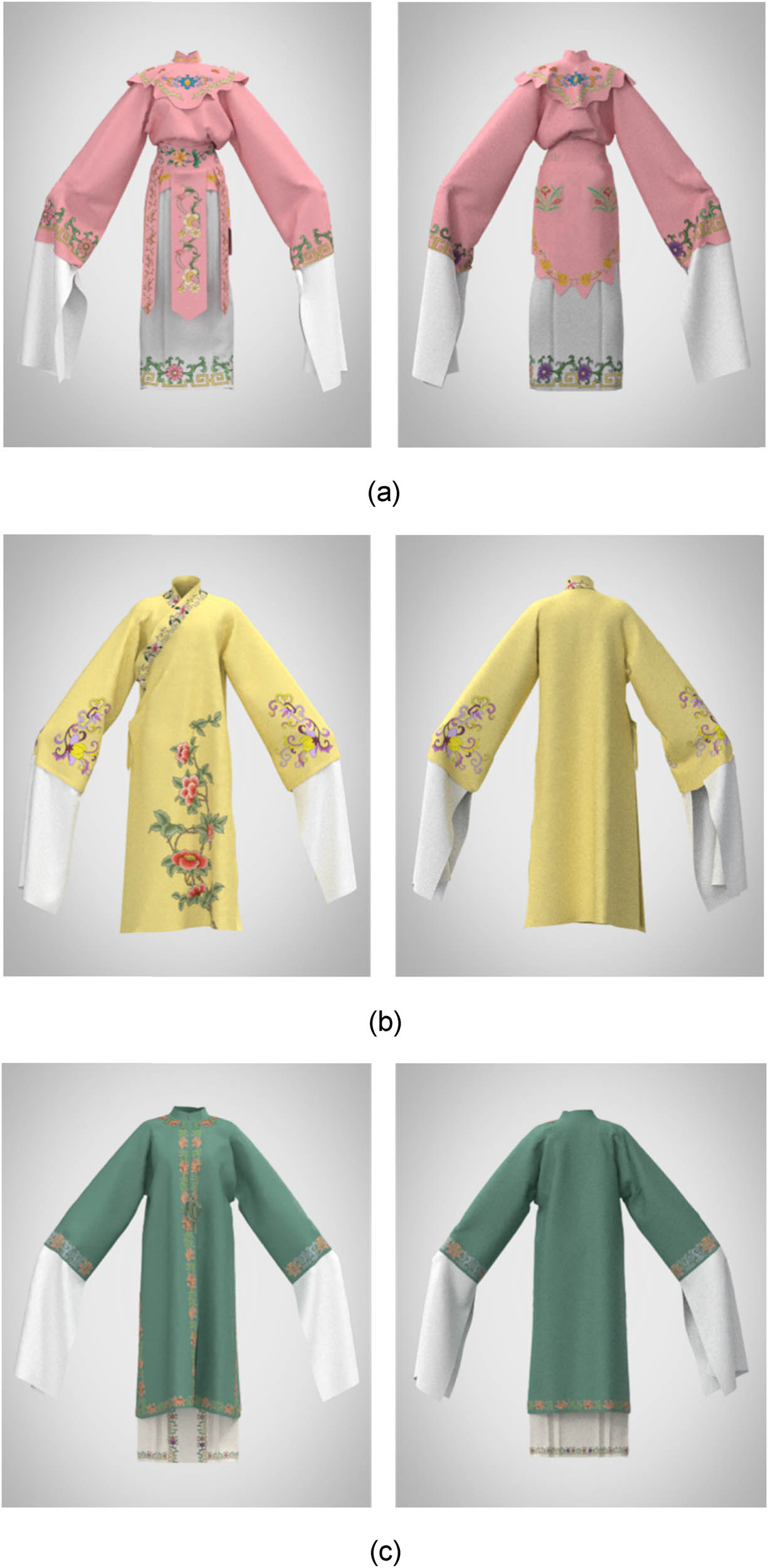
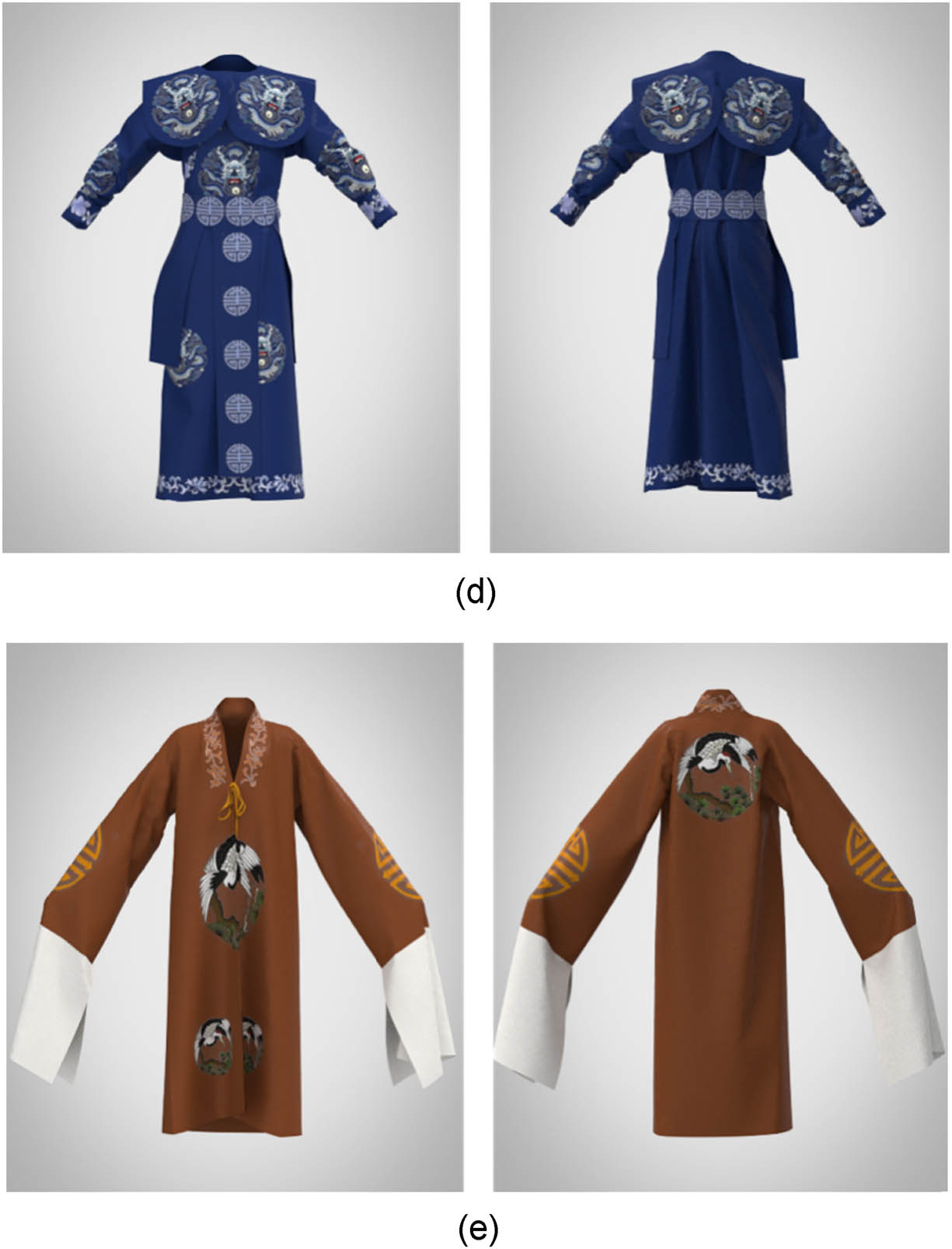
Virtual simulation images of Yue opera costumes for different roles. (a) Huadan (young females), (b) Shusheng (young males), (c) Zhengdan (primarily middle-aged females), (d) Wusheng (young and middle-aged male martial artists), and (e) Laosheng (senior males).
4.2 Aesthetic effect
To assess the aesthetic effects of Yue Opera costumes, a set of 16 items was included in the measurement. We expected to see the influence of objective elements of Yue Opera costumes on the whole aesthetic experience through the network modeling. Therefore, unlike the work of AEN, our measurement table contained a wider range of objects. From the order of abstraction from low to high, these items consist of three items that measured the audience’s perception of the low-level design elements (L1–L3), five items of semantic difference (S1–S5), and eight items of abstract aesthetic experience (A1–A8) (Table 1). Specifically, the liking for underlying design elements measures the evaluations of the color, pattern, and shape of the garment. The semantic differential measurement included five groups of semantic scales, with each group consisting of semantically opposite word pairs, i.e., sober–showy, elaborate–simple, dim–conspicuous, low level–high level, light–heavy, as referenced from Han’s research findings [57]. Here, we aimed to incorporate semantic differential measurements to gauge the audience’s perceptual imagery based on the basic design elements. In addition, we contextualized the measures based on scales such as the ARS [37], the Aesthetic Emotion Scale [38], and the AEQ [39], which were originally developed to assess the aesthetic experience of different artworks. Compared with L1–L3 and S1–S5, A1–A8 described more abstract aesthetic sensations, such as emotions, interests, understanding of costumed characters, and so on. All measurement scales were presented in the form of a seven-point scale, allowing participants to freely rate their evaluations of Yue Opera simulation images. The inclusion of these scales and experimental stimuli formed a 16-item experimental design, enabling a relatively comprehensive examination of the audience’s aesthetic responses to Yue Opera costumes.
Aesthetic experience scale of Yue Opera costumes
| Serial number | Measurement item |
|---|---|
| L1: pattern | I really like the pattern on this costume |
| L2: color | I like the color of this costume |
| L3: shape | I love the shape of this costume |
| S1: showy | sober–showy |
| S2: simple | elaborate–simple |
| S3: conspicuous | dim–conspicuous |
| S4: high level | low level–high level |
| S5: heavy | light–heavy |
| A1: archetypal aesthetic | I think this costume is beautiful |
| A2: negative emotion | When I saw this costume, I was confused |
| A3: positive emotion | Overall, I was happy when I saw this costume |
| A4: knowledge | I want to know the cultural knowledge about this costume |
| A5: interesting | I thought it would be interesting to explore the costume |
| A6: character | This costume reminds me of the corresponding artistic character image |
| A7: creative intent | I know what the creators are trying to convey with this costume |
| A8: life experience | This costume reminds me of certain life experiences from the past |
4.3 Participants
Our experimental subjects were mainly focused on the youth group. The primary reason for choosing this group is the aging audience of Yue Opera in real life, with most being over 50 years old, leading to a potential generational gap in its inheritance. To investigate the visual aesthetic preferences of younger audiences toward Yue Opera, our study specifically targeted this group. The questionnaire was administered on the NAODAO online research platform [57] (www.naodao.com), and the participants consisted of registered members of the platform who were mainly youth in China. The experiment followed the ethical norms of the platform. A total of 257 participants were recruited, including 80 males, 170 females, and 7 who were not willing to disclose their gender. The mean age of the participants was 26.06 years with a standard deviation of 7.33 years. Among the participants, 159 individuals were aged 18–25 years, comprising 61.87% of the sample; 34 were aged 25–30 years, accounting for 13.23%; and 64 were older than 30 years, making up 24.90%. They were given informed consent before the participation.
4.4 Procedure
The experiment was developed using PsychoPy [58] version 2022.2.4 and conducted on the NAODAO online research platform. The detailed procedure is outlined in Figure 2.
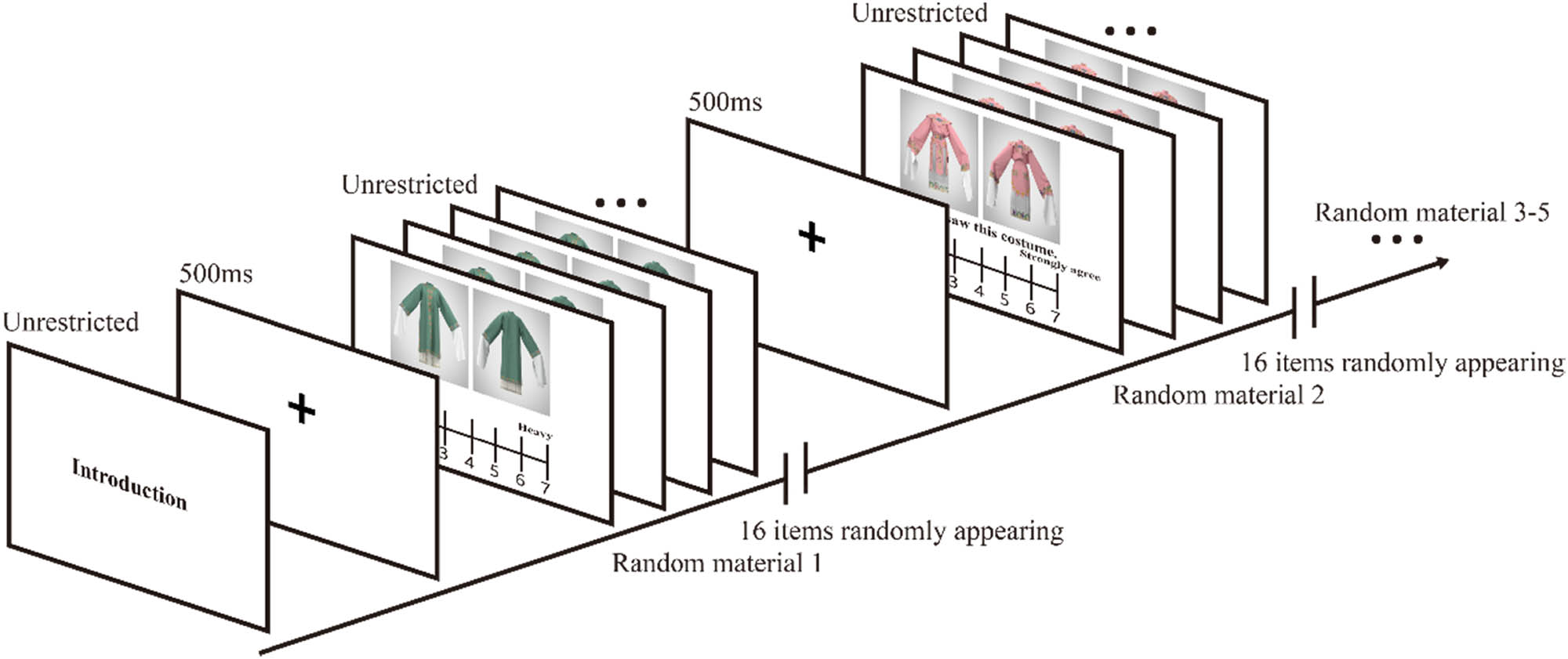
Experimental procedure.
Before the start of the experiment, participants were provided with an instruction guide explaining the procedure. This ensured that participants had a clear understanding of the evaluation criteria, which means score should be based on current viewing experience, and there was not a right or wrong answer. The experiment consisted of 80 questions (5 pictures depicting different characters in Yue Opera costumes × 16 items). Participants used their mouse to rate each question on a seven-point scale, ranging from 1 to 7 including decimals. There was a 500 ms interval before each image appeared, and participants were not restricted by time limits when answering the questions. To maintain validity, data from subjects whose total participation time were less than 3 min were excluded. After verifying the collected data, participants were compensated with a subject fee as a token of appreciation.
4.5 Network estimation
To estimate the network of aesthetic effects, we referred to the analysis source code of Specker et al. [19], which followed the approach of Rhemtulla et al. [49] and Fried et al. [50]. All analyses were conducted in R using the “qgraph” package [59] within a Gaussian graphical model (GGM) framework. The GGM represents a network in which the edges connecting aesthetic effects estimate partial correlations, incorporating graphical lasso regularization. In the GGM, the edges can be interpreted as conditional dependencies between aesthetic effects. If two aesthetic effects are connected in the outcome graph, it indicates a dependency between them after controlling for all other variables. Conversely, if no edges appear, the aesthetic effects are conditionally independent. Regularization involves estimating a statistical model with an additional penalty for model complexity [53]. The global network is an average over the estimates of the individual networks for each costume. The gamma was set as 0.5.
To test the stability, the CS coefficients of the expected influence for five individual networks were calculated and all above 0.5, suggesting a relative estimated robustness. The stability of central indices, bootstrapped confidence intervals of estimated edge-weights, and the figures showing if the edges significantly differ from each other (nBoots = 2000) are shown in Figure A1.
5 Results
5.1 Descriptive statistics
Figure 3 presents the mean scores for each scale. A two-way analysis of variance (ANOVA) indicated that the subjects’ scores differed significantly on costume (F = 38.700, p = 0.000, η² = 0.131), item (F = 278.118, p = 0.000, η² = 0.521), and their interaction (F = 57.632, p = 0.000, η² = 0.184). Table 2 shows the detailed effects of the dress type on subjects’ scores on each item. It can be seen that negative emotion (A2) has the lowest score among the five networks. L1–L3 (liking of pattern, color, and shape) and S1–S5 (showy, simple, conspicuous, high level, heavy) had relatively large differences in the scoring results. In comparison, the scores of A1–A8 (high-level aesthetic scales) had almost similar trends.

Average score on the aesthetic effect scale.
Correlation matrix of Yue Opera costumes for different roles
| Artwork | Huadan | Shusheng | Zhengdan | Wusheng | Laosheng |
|---|---|---|---|---|---|
| Huadan | 0.967 | 0.952 | 0.936 | 0.970 | |
| Shusheng | 0.646 | 0.965 | 0.918 | 0.950 | |
| Zhengdan | 0.633 | 0.616 | 0.944 | 0.958 | |
| Wusheng | 0.723 | 0.673 | 0.652 | 0.977 | |
| Laosheng | 0.704 | 0.642 | 0.757 | 0.694 |
Note: Lower triangle is adjacency matrix correlations, and upper triangle is centrality correlations.
In addition, we categorized our samples into male and female groups to analyze the impact of gender differences on aesthetic experience. Most aesthetic preferences showed no significant distinctions between genders. However, for four specific questions – namely, “low level-high level,” “I want to know the cultural knowledge about this costume,” “I know what the creators are trying to convey with this costume,” and “This costume reminds me of certain life experiences from the past” – male responses scored slightly higher than female on average (t = −2.028, p = 0.044; t = −2.351, p = 0.020; t = −2.712, p = 0.007; t = −4.691, p = 0.000). This subtly suggests that females may have higher standards for the quality of Yue Opera costumes and are more cautious in their understanding of the cultural knowledge and creative intentions behind these costumes.
5.2 Global network
We first explain the overall network of Yue Opera costume aesthetics (averaged across all five individual networks), as shown in Figure 4, which represents a preliminary explanation of the relationship between aesthetic structures. The blue line connection represents the positive correlation, and the red line connection represents the negative correlation. The wider the line, the larger the partial correlation coefficient. According to the prompt of “qgraph”, care needs to be taken in interpreting very small relationships since a dense regularized network was selected, and we set edges with weights below 0.05, which is not shown in the figure. In this network, there was a strong positive correlation between A1: archetypal aesthetics and cloth L1: pattern (0.226), L2: color (0.209), L3: shape (0.116), A3: positive emotion (0.140), S4: high-level (0.137), and A5: interesting (0.122). Overall, based on the relative distance of the nodes in the network, they can be roughly categorized into three groups: the first group (L1–L3, A1–A5, and S4) where archetypal aesthetic was the center, the second group (A6–A8) representing self-reference and professional knowledge, and the last group (S1–S3 and S5) representing semantic evaluations expect for the sense of high-level. Among the groups, conspicuous (S3), creative intent (A7), knowledge (A4), positive emotion (A3), and shape (L3) could be seen “bridges” that triggered the connection of the three groups to a certain extent.
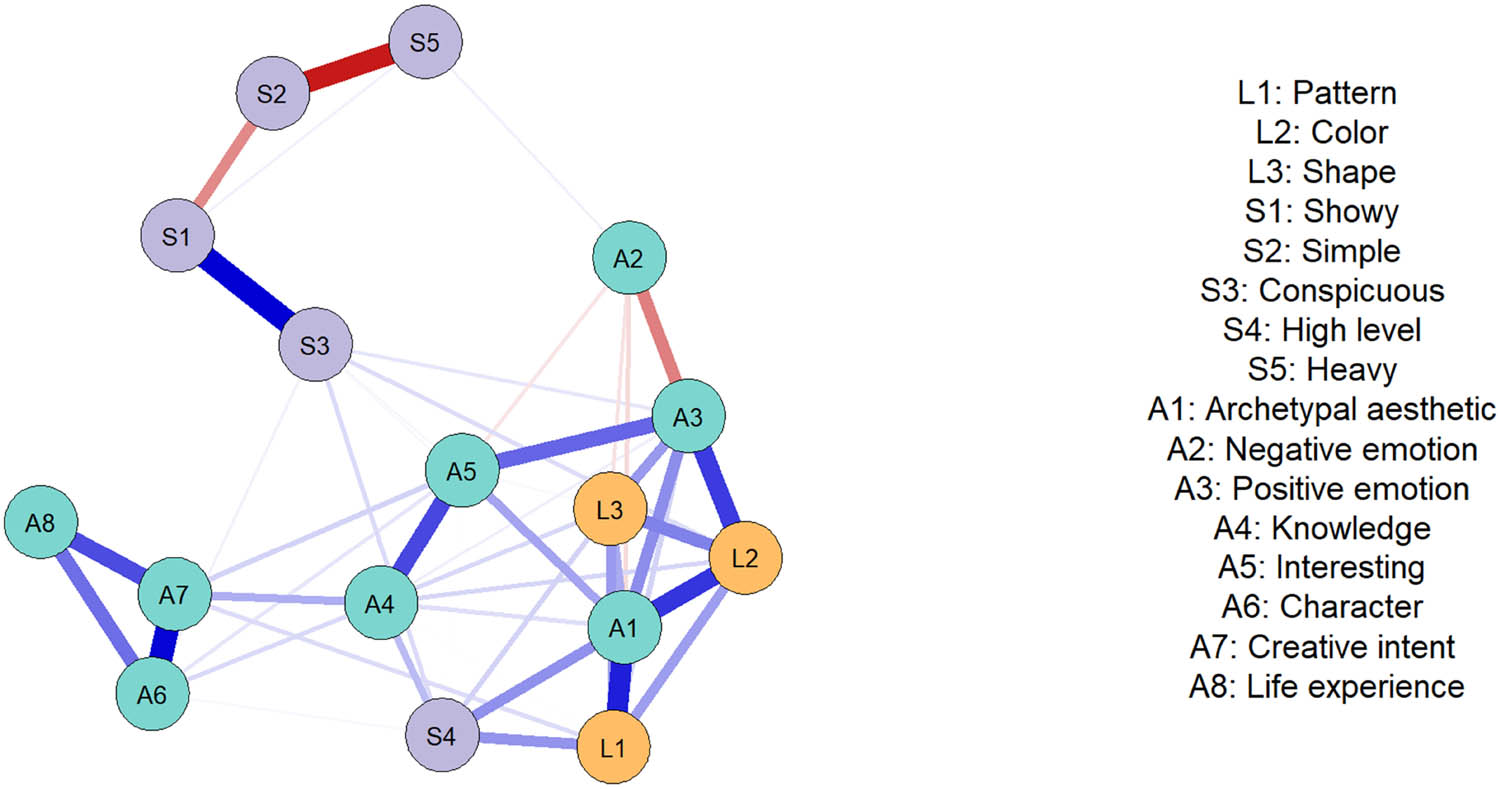
Global network of aesthetic effects across all Yue Opera costumes.
Considering that the grouping was based on networks without small edges, we further utilized unregularized GGM modeling (ggmModSelect) to calculate and generate the global network again. According to Figure A2, a similar layout can still be derived.
Like the analysis of AEN, we calculated the expected influence of each node (Figure 5a). Averagely, A1: archetypal aesthetics had the highest expected influence in the network (1.046), followed by the liking of L1: pattern (0.667) and L2: color (0.827). The liking of L3: shape (0.453), S4: high-level (0.406), A3: positive emotion (0.439), A4: knowledge (0.631), A5: interesting (0.496), A6: character (0.461), and A7: creative intent (0.481) had similar expected influence. A2: negative emotion (−2.208) had the lowest expected impact, followed by S2: simple (−1.776) and S5: heavy (−1.632).

Expected influence of nodes of the global network (a) and individual networks (b).
5.3 Network for different characters
Since the network structure may be different due to character creations, we illustrated the Yue Opera costume aesthetic network for each different character in Figure 6. Edges with weights below 0.1 were not shown. It can be seen that the basic network structures showed a strong similarity despite the larger differences in the ratings caused by the costumes. For example, there was a positive correlation between prototype aesthetics and color, pattern, shape, and high level. The simple feeling was negatively correlated with heavy presence. The awakening of past life experience was related to the understanding of creative intention and character creation. The semantic “conspicuous” (S3) was an important “bridge” to trigger other semantic evaluations.
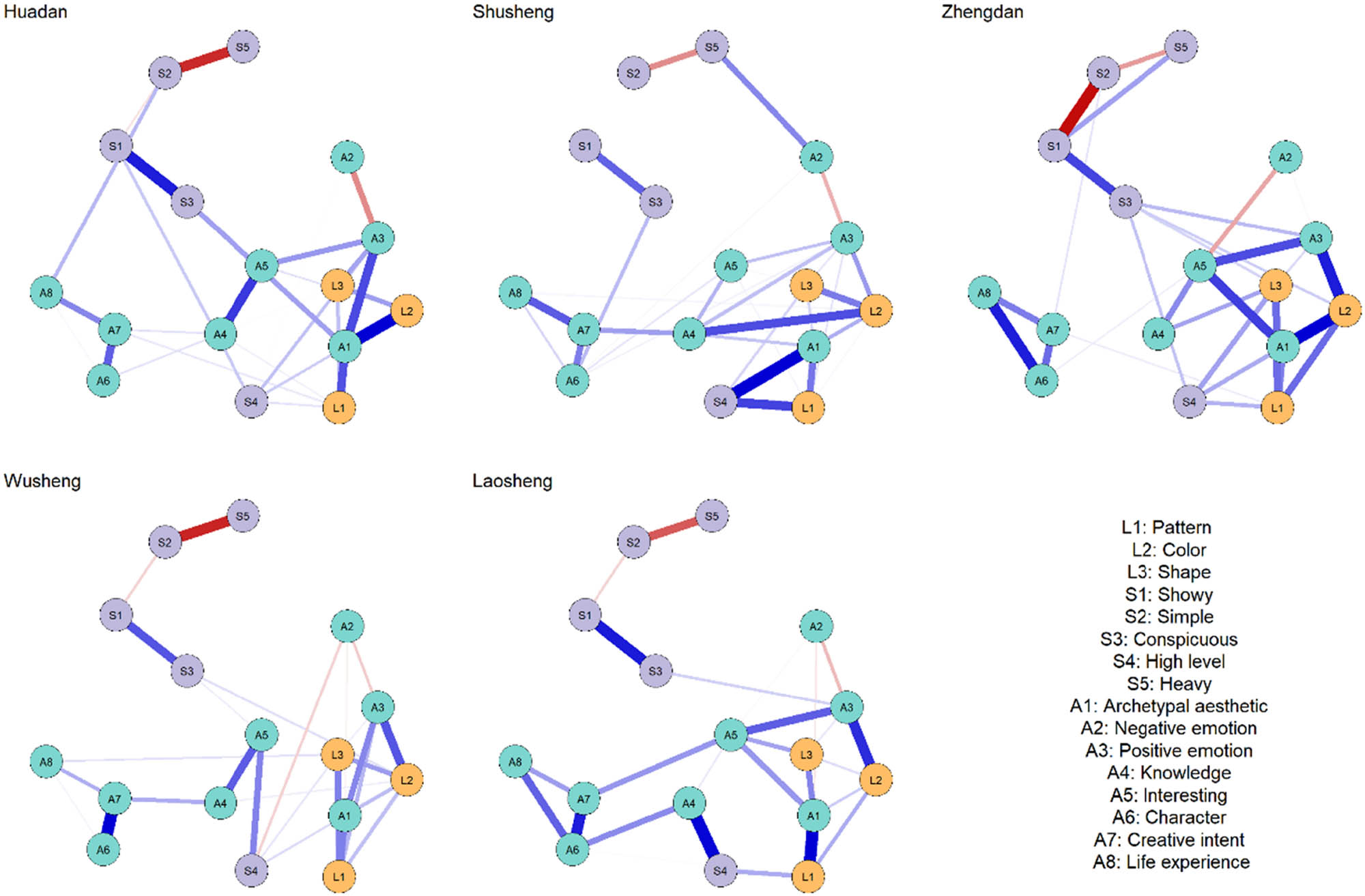
AEN for each individual Yue Opera costume.
There was also a large degree of similarity in the centrality of clothing aesthetics of different characters (Figure 5b). For instance, the expected influence of archetypal aesthetic (A1) was the highest, and negative emotions (A2), heavy (S5), and simple (S2) had lower expected influence values. The network similarity index of the relational adjacency matrix and the centrality in Table 2 also reflect the generalizability of the conclusions to different Yue Opera costumes. The adjacency matrix correlation was between 0.62 and 0.72. The centrality correlation was even stronger, all above 0.90. In the AEN study [19], the adjacency matrix correlations of artworks ranged from 0.51 to 0.83, and the centrality matrix correlations ranged from 0.42 to 0.87.
However, the aesthetic network of Yue Opera costumes of different characters also had some differences. We then evaluated the variability of edge weights across the network to find the unstable relationships.
5.4 Variability network
Figure 7 represents a network where edges represent variability in connection strength between costumes. The edges below 0.05 were not shown, and the remained network was scaled from 0.05 to 0.11. In this network, the greatest variability raised between S4: high level and A4: knowledge (0.103), A1: archetypal aesthetic and S4: high level (0.095), and A5: interesting and S4: high level (0.095). As shown in Figure 6, the differences between these associations with high level (S4) and knowledge (A4) were mainly driven by the clothing of Laosheng, in the network of which the semantics “high level” (S4) and knowledge (A4) were positively correlated (0.274), and in the remaining four, they were weakly or hardly correlated (Huadan: 0.078; Shusheng: 0; Zhengdan: 0.103; and Wusheng: 0.059). The difference in associations between “high level” (S4) and archetypal aesthetic (A1) was mainly caused by the clothing of Laosheng (0.064) and Huadan (0.045). In these two networks, they were hardly correlated, and the remaining three networks had a positive correlation (Shusheng: 0.283; Wusheng: 0.133; and Zhengdan: 0.162). The difference in the associations between high level (S4) and interesting (A5) was mainly caused by the clothing of the Wusheng. The nodes “high level” (S4) and interesting (A5) included a positive association (0.219), while the other costumes were hardly associated.
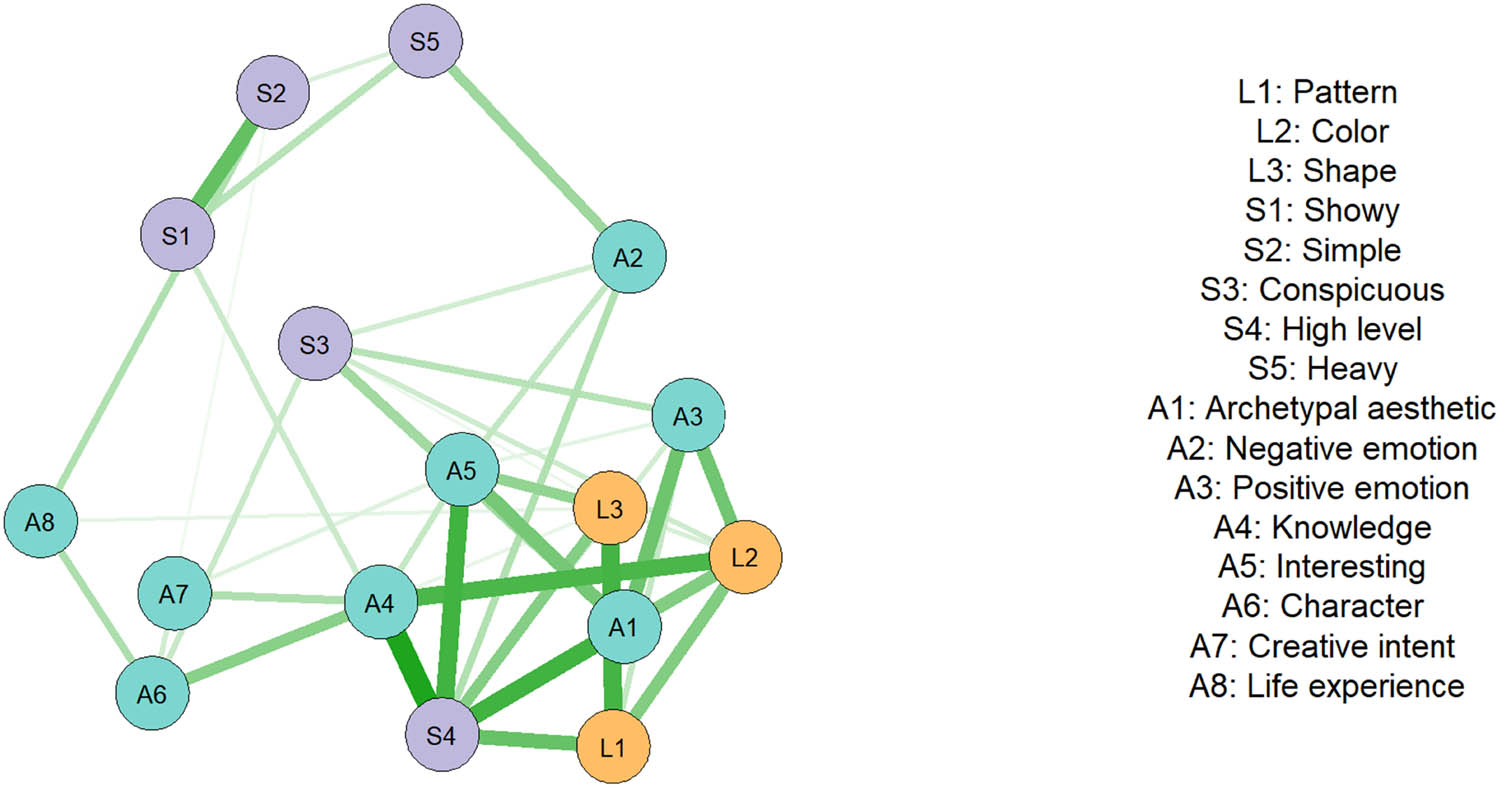
Variability network.
Overall, these results suggest some differences in the associations between the aesthetic effects of works that rely on digital images of Yue Opera costumes, especially in semantic evaluation “high-level” and background knowledge understanding. Nevertheless, the basic structure of the AEN appeared to be relatively similar.
6 Discussion
6.1 General network analysis
This study centered on the investigation of the aesthetic effects provided by simulated Yue Opera costumes portraying different roles. To achieve this, we applied the AEN model [19] to delve into the aesthetics of Yue Opera costumes. This approach allowed us to elucidate the network structure underlying the aesthetic impact of distinct role-based costumes. Notably, we identified a higher positive correlation between preferences (archetypal aesthetics) and color, pattern, and shape design elements, the semantic “high-level” as well as the cognition of aesthetic emotions (interesting). The influence of color on people’s perception and emotion had been discovered for a long time [60,61]. The finding about color, pattern, and semantics is partly in alignment with Han’s research [57]. These elements collectively formed the foundation of the aesthetic network inherent within Yue Opera costumes.
Of particular significance was the semantic descriptor “conspicuous,” which emerged as a pivotal “bridge” connecting the fundamental aesthetic network to the semantic evaluative network within Yue Opera costumes. The understanding of creative intent (A7), knowledge (A4), and positive emotion (A3) also played the role of “bridge” in the aesthetic network. Manipulating these nodes may change the relative ones in the whole aesthetic network. Therefore, it is significant to pay special attention to these contents in the process of costume design of Yue Opera.
In addition, a distinct interconnected group emerged, encompassing the comprehension of characterization, recollection of past experiences, and understanding of creative intent. A positive correlation was discerned among these elements. Their combined influence contributes significantly to the aesthetic network of Yue Opera costumes by facilitating the audience’s grasp of the contextual knowledge surrounding the costumes. This finding is somehow consistent with the conclusions drawn by Leder et al. [6]. The network configuration also resonates with the aesthetic triad pattern postulated by Chatterjee and Vartanian [33], which posited that the aesthetic experience is underpinned by a triadic framework encompassing the sensorimotor system, the emotion evaluation system, and the meaning knowledge system. Each of these systems possesses distinct neural foundations.
6.2 Role-based comparisons
In addition, we observed the difference in networks of role-based Yue Opera costumes. In the aesthetic network of Laosheng, high level (S4) and knowledge (A4) were positively correlated, while in the remaining four, they were weakly or not correlated. The possible explanation was that for Laosheng costumes, the audience understood the “high-level” sense of clothing from the top-down driven by cultural knowledge (the crane in the cloth is a symbol of longevity in Chinese culture), while other costumes may be more inclined to be viewed from the bottom-up based on the underlying design elements and other aspects. The difference in associations between high level (S4) and archetypal aesthetic (A1) was mainly caused by the clothing of Laosheng and Huadan. In these two networks, they were hardly correlated. This may indicate that the sense of “high-level” was not important in their archetype aesthetic evaluation. Specifically, in the aesthetic network of Laosheng, the archetype aesthetic was highly correlated with the underlying design elements (color, shape, and pattern) and interesting feelings. In the aesthetic network of Huadan, the archetypal aesthetic was closely related to the underlying design elements, positive emotions, and conspicuous feelings. The difference in the associations between high level (S4) and interesting (A5) was mainly caused by the clothing of the Wusheng. Through the later interview with the audience, we learned that the audience had a great interest in the dragon pattern in Wu Sheng’s clothing, which is the symbol of the emperor in Chinese history, making them have the association of “majesty” and “advanced” sense.
The establishment of this network model reminds us that to improve the dissemination and acceptance process of Yue Opera costumes, we can start from the design elements of costumes such as patterns, colors, and silhouettes to develop styles that audiences like [62,63]. It is also encouraged to strengthen the introduction of its background knowledge, arouse public’s past life experience, and convey the creator’s design intention. At the same time, we noticed that conspicuous (S3) semantic evaluation was an important node in the public’s aesthetic evaluation of such clothing. According to Chatterjee’s information processing model, attention is an important prerequisite for aesthetic evaluation [64]. Therefore, some details should be designed to be eye-catching in the digital costume design of Yue Opera.
6.3 Limitations and future directions
It should be noted that network analysis is a newly emerging research methodology in the field of psychological cognition in recent years. Inevitably, our research also possesses certain limitations. First, the relevant data were obtained from self-reports, which may have a certain social approval effect. A possible solution is to introduce objective measurement tools, such as eye trackers and electrocardiographs, to obtain a more realistic response from the audience. Second, the study was a cross-sectional design, and no causal conclusions can be drawn. Future research can examine the changes in the aesthetic structure through longitudinal tracking and can also test whether the intervention on aesthetic core emotions and cognition is more effective by improving the costume design of Yue Opera. Third, the main focus of this study is the youth group, and it is important to also consider the visual aesthetic preferences of both older individuals and the young to middle-aged groups toward Yue Opera. Moving forward, we aim to conduct age-stratified experiments to comparatively analyze the aesthetic preferences across various age groups. Fourth, in the aesthetics of Yue Opera costumes, accessories such as headpieces and shoes play a significant role. These accessories, including headpieces, possess unique design elements. Future research could incorporate Yue Opera’s headpieces, shoes, and other accessories into the study scope, making the research framework more comprehensive. Fifth, we designed five simulation images outfits for five common characters. However, in Yue Opera, the design elements of costumes can vary significantly among different characters. This factor was not considered in our current experiment. In future research, we plan to explore how changes in the design elements of a single character’s clothing might influence aesthetic experiences.
7 Conclusion
To sum up, grounded in the aesthetic cognition theory, this exploratory study focuses on Yue Opera costume virtual simulation images to examine audience’s aesthetic cognition process and outcomes. According to the characteristics of the five main roles in Yue Opera costumes, we designed corresponding virtual simulation costume images, serving as experimental materials. We gathered evaluations from 257 participants online regarding the underlying design elements, semantics, and abstract aesthetic experience. Based on the network perspective, this study discussed the characteristics of the inferred average network structure of Yue Opera costume aesthetics and compared the differences between the costumes for specific roles. It is expected to enhance the understanding of the aesthetic cognitive process of Yue Opera costumes to a certain extent and provide practical guidance and a data basis for the targeted aesthetic design of Yue Opera costumes.
Acknowledgments
We would like to thank the anonymous reviewers for their valuable comments and suggestions during the revision process of the manuscript.
-
Funding information: The work was financially supported by the Ministry of Culture and Tourism of China Social Science Research Project (23DY31), the Cultivation of Leading Talents in Philosophy and Social Sciences of Zhejiang Province of China (21YJRC02-1YB), the Basic Scientific Research Operation Fund of Central Universities of China (S20230301), and Zhejiang Social Science Planning Project (19NDQN328YB).
-
Conflict of interest: The authors state no conflict of interest.
Appendix
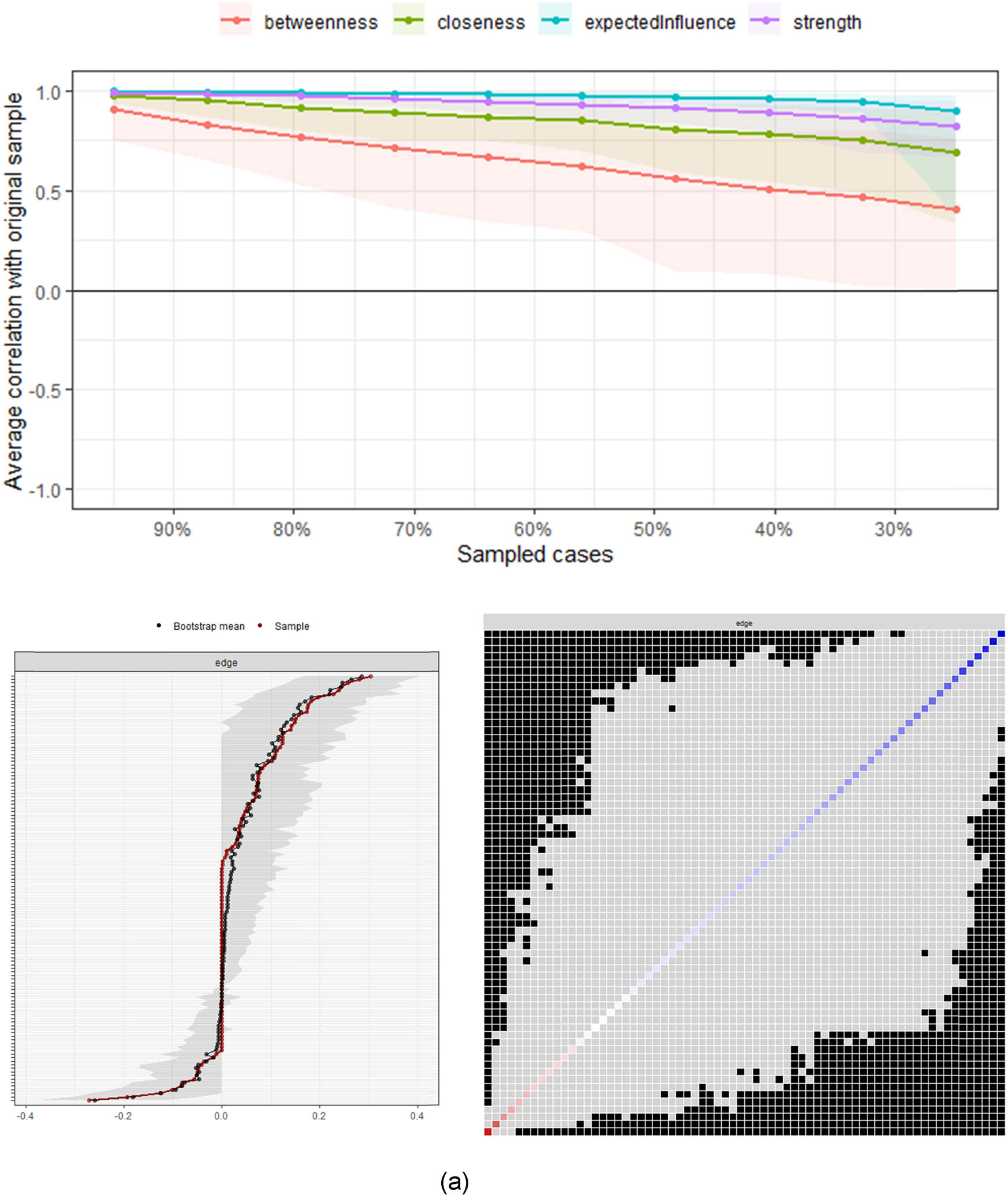
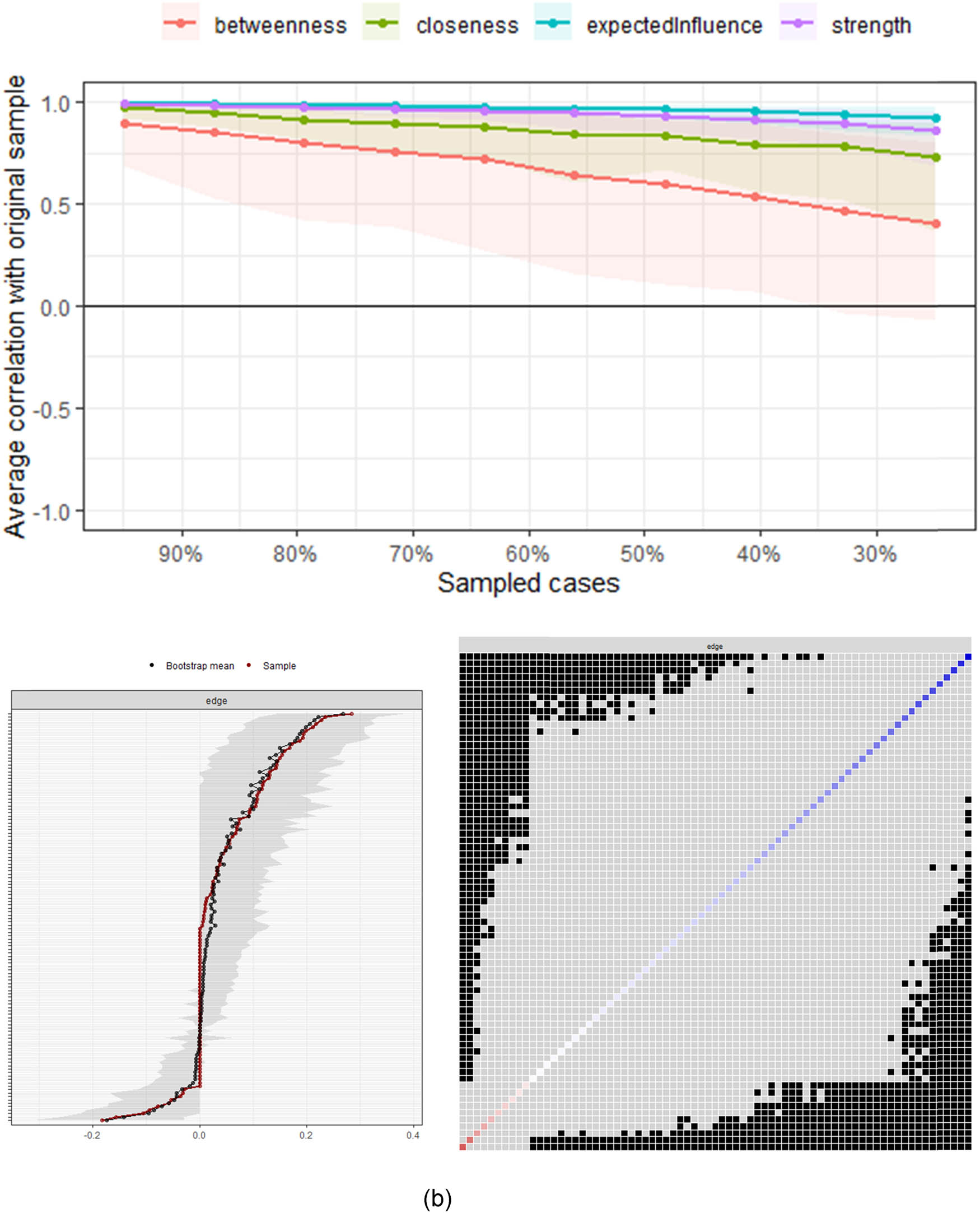
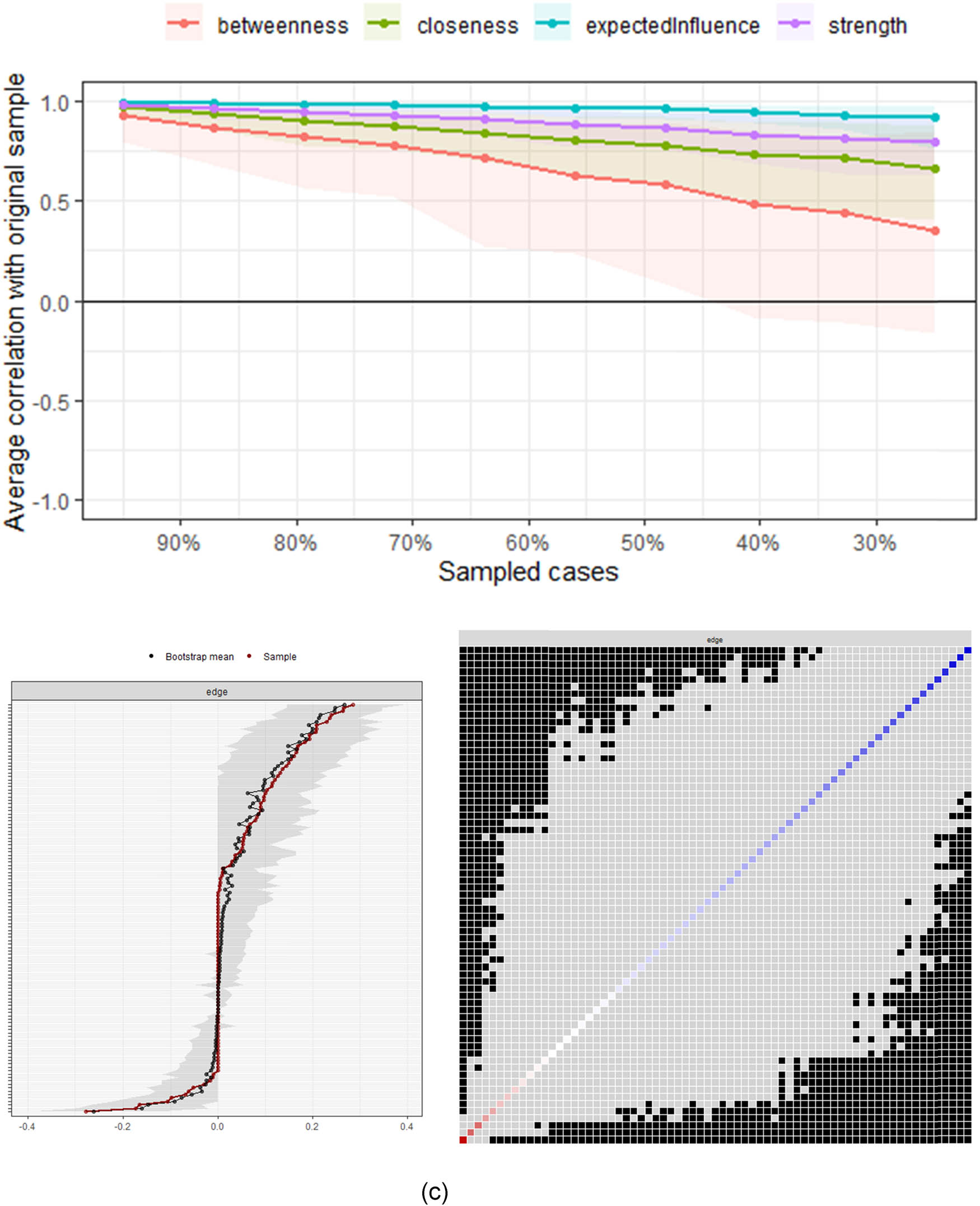
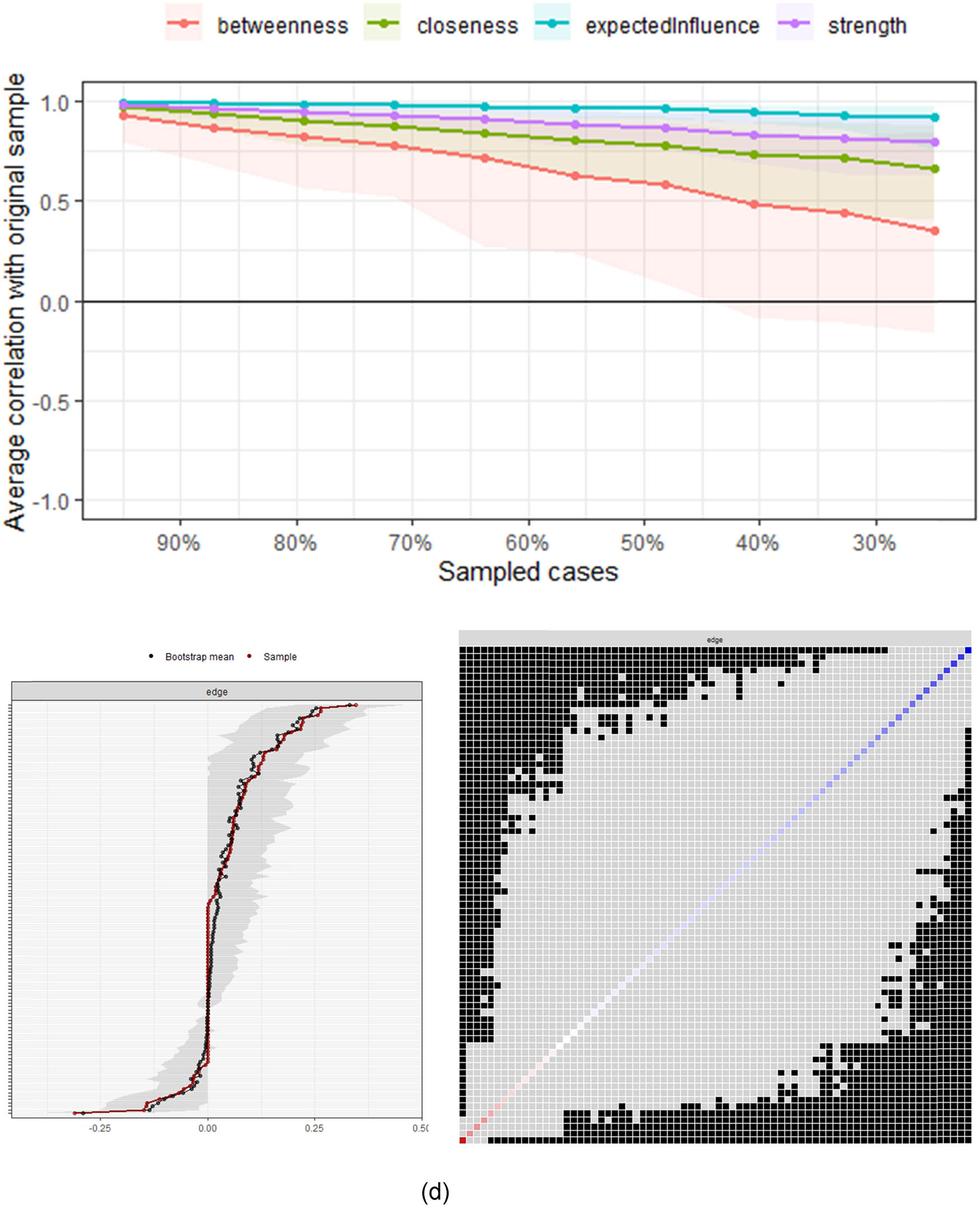
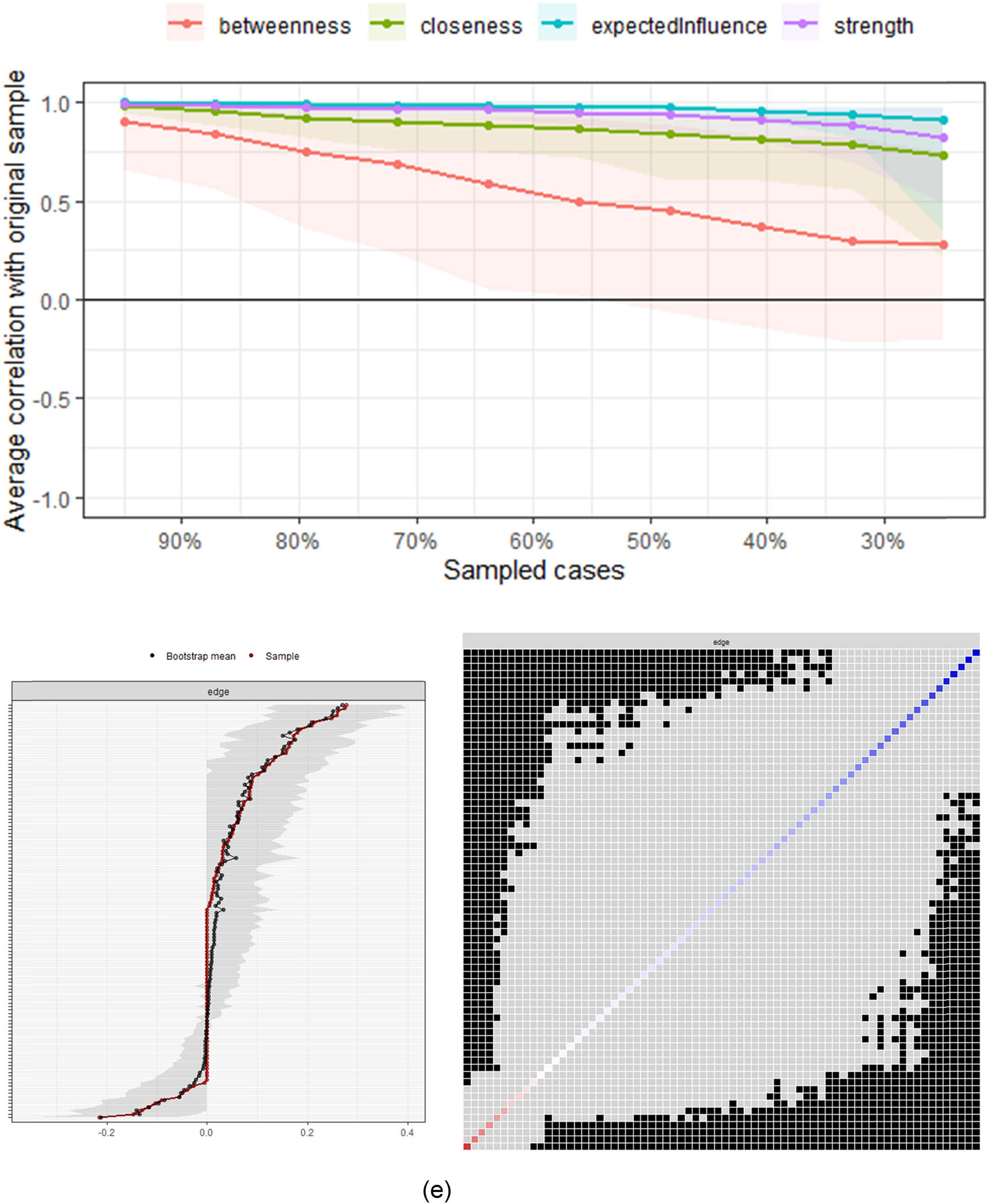
The stability of central indices, bootstrapped confidence intervals, and the difference test of edge-weights for each material. (a) Huadan, (b) Shusheng, (c) Zhengdan, (d) Wusheng, and (e) Laosheng.
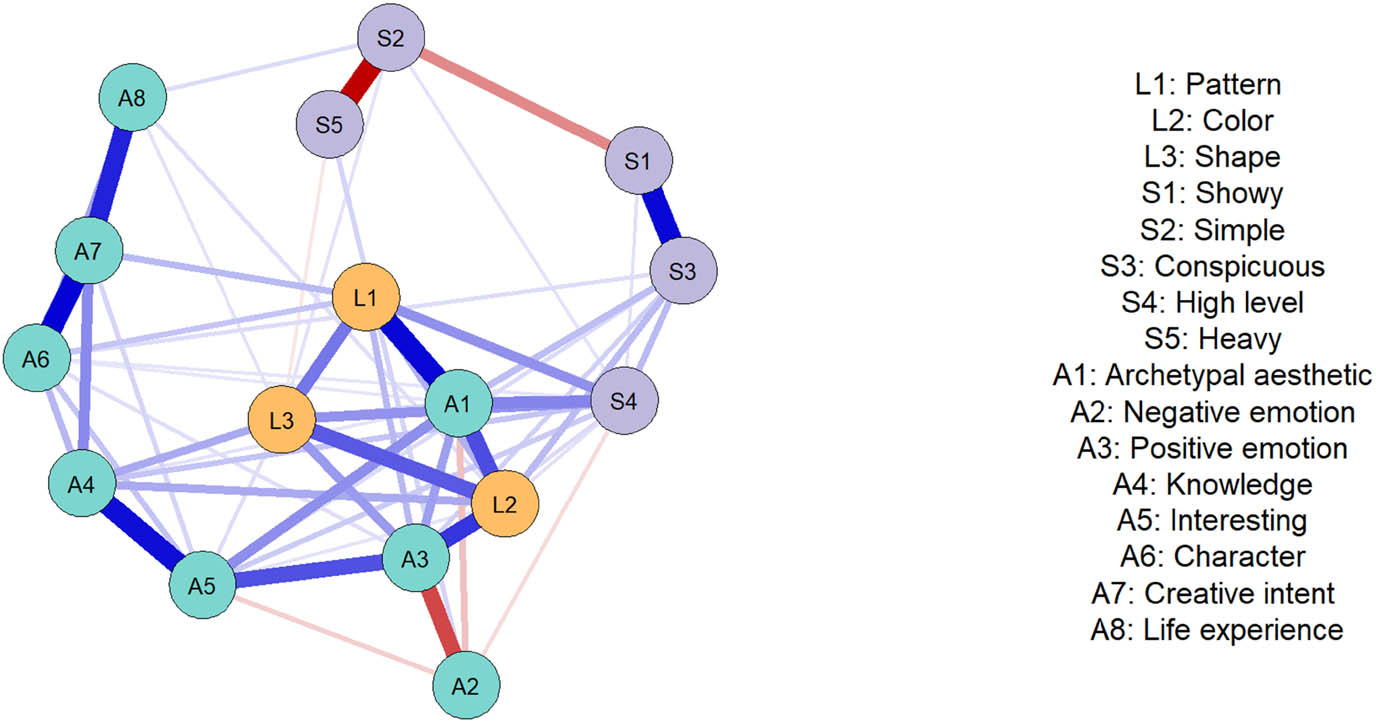
Unregularized global network of aesthetic effects across all Yue opera costumes.
ANOVA of aesthetic effects across five costumes
| Variable | df | F | p | η² |
|---|---|---|---|---|
| L1: pattern | 3.715 | 14.572 | 0.000 | 0.054 |
| L2: color | 3.857 | 48.206 | 0.000 | 0.158 |
| L3: shape | 3.617 | 17.627 | 0.000 | 0.064 |
| S1: showy | 3.781 | 140.096 | 0.000 | 0.354 |
| S2: simple | 3.746 | 152.981 | 0.000 | 0.374 |
| S3: conspicuous | 3.502 | 91.602 | 0.000 | 0.264 |
| S4: high level | 4 | 6.037 | 0.000 | 0.023 |
| S5: heavy | 3.764 | 109.589 | 0.000 | 0.300 |
| A1: archetypal aesthetic | 3.780 | 26.573 | 0.000 | 0.094 |
| A2: negative emotion | 3.872 | 9.820 | 0.000 | 0.037 |
| A3: positive emotion | 3.589 | 31.932 | 0.000 | 0.111 |
| A4: knowledge | 3.805 | 10.522 | 0.000 | 0.039 |
| A5: interesting | 3.726 | 14.346 | 0.000 | 0.053 |
| A6: character | 3.816 | 8.203 | 0.000 | 0.031 |
| A7: creative intent | 3.841 | 5.145 | 0.001 | 0.020 |
| A8: life experience | 3.819 | 10.720 | 0.000 | 0.040 |
References
[1] Liu, K., Zhou, S., Zhu, C., Lü, Z. (2022). Virtual simulation of Yue Opera costumes and fashion design based on Yue Opera elements. Fashion and Textiles, 9(1), 31.10.1186/s40691-022-00300-0Search in Google Scholar
[2] Cupchik, G. (2014). Theoretical foundations for an empirical aesthetics. In: Tinio, P., Smith, J. (Eds.). The Cambridge Handbook of the Psychology of Aesthetics and the Arts (Cambridge Handbooks in Psychology) (pp. 60–85). Cambridge University Press, Cambridge. 10.1017/CBO9781139207058.005.Search in Google Scholar
[3] Hodin, J. P., Valentine, C. W. (1965). The experimental psychology of beauty. Art Journal, 24(3), 302. 10.1080/00043249.1965.10794634.Search in Google Scholar
[4] Zeki, S. (2002). Inner vision: An exploration of art and the brain. Journal of Aesthetics and Art Criticism, 60(4), 365–366.Search in Google Scholar
[5] Jacobsen, T. (2009). Neuroaesthetics and the psychology of aesthetics. In: Skov, M., Vartanian, O. (Eds.). Neuroaesthetics (pp. 27–42). Baywood Publishing Co., Amityville.10.4324/9781315224091-3Search in Google Scholar
[6] Leder, H., Belke, B., Oeberst, A., Augustin, D. (2004). A model of aesthetic appreciation and aesthetic judgments. British Journal of Psychology, 95(4), 489–508.10.1348/0007126042369811Search in Google Scholar PubMed
[7] Silvia, P. J. (2005). Cognitive appraisals and interest in visual art: Exploring an appraisal theory of aesthetic emotions. Empirical Studies of the Arts, 23(2), 119–133.10.2190/12AV-AH2P-MCEH-289ESearch in Google Scholar
[8] Jacobs, A. M. (2015). Neurocognitive poetics: Methods and models for investigating the neuronal and cognitive-affective bases of literature reception. Frontiers in Human Neuroscience, 9, 186.10.3389/fnhum.2015.00186Search in Google Scholar PubMed PubMed Central
[9] Burke, M. (2015). The neuroaesthetics of prose fiction: pitfalls, parameters and prospects. Frontiers in Human Neuroscience, 9, 442.10.3389/fnhum.2015.00442Search in Google Scholar PubMed PubMed Central
[10] Pelowski, M., Leder, H., Mitschke, V., Specker, E., Gerger, G., Tinio, P. P., et al. (2018). Capturing aesthetic experiences with installation art: An empirical assessment of emotion, evaluations, and mobile eye tracking in Olafur Eliasson’s “Baroque, Baroque!”. Frontiers in Psychology, 9, 1255.10.3389/fpsyg.2018.01255Search in Google Scholar PubMed PubMed Central
[11] Li, L., Duan, J., Yang, Y., Xu, L., Li, Y., Guo, Y. (2022). Psychology inspired model for hierarchical image aesthetic attribute prediction. 2022 IEEE International Conference on Multimedia and Expo (ICME) (pp. 1–6).10.1109/ICME52920.2022.9859845Search in Google Scholar
[12] Calvo-Merino, B., Jola, C., Glaser, D. E., Haggard, P. (2008). Towards a sensorimotor aesthetics of performing art. Consciousness and Cognition, 17(3), 911–922.10.1016/j.concog.2007.11.003Search in Google Scholar PubMed
[13] Brattico, E., Pearce, M. (2013). The neuroaesthetics of music. Psychology of Aesthetics, Creativity, and the Arts, 7(1), 48.10.1037/a0031624Search in Google Scholar
[14] Kodžoman, D, Hladnik, A, Čuden, A. P., Čok, V. (2023). Assessment and semantic categorization of fabric visual texture preferences. AUTEX Research Journal, 23(2), 279–291.10.2478/aut-2022-0006Search in Google Scholar
[15] Li, Q. W., Wang, J. P., Yang, Y. L., Zhang, B. J., Li, Z. L., Wang, L. (2021). Cognitive evaluation of men’s suit style based on image scales. Journal of Textile Science, 42(4), 149–154.Search in Google Scholar
[16] Wei, W. D., Liu, C. X. (2021). Attention and Kansei evaluation of distorted visual illusion clothing images. Silk, 58(7), 6.Search in Google Scholar
[17] Chen, Y. F., Liu, C., Yang, M. (2022). Emotion measurement of one-piece swimsuit structure based onresponse surface analysis. Journal of Textile Science, 43(10), 161–168.Search in Google Scholar
[18] Ge, B., Shaari, N., Yunos, M. Y. M., Abidin, S. Z. (2023). Group consumers’ preference recommendation algorithm model for online apparel’s colour based on Kansei engineering. Industria Textila, 74(1), 81–89.10.35530/IT.074.01.202268Search in Google Scholar
[19] Specker, E., Fried, E. I., Rosenberg, R., Leder, H. (2021). Associating with art: A network model of aesthetic effects. Collabra: Psychology, 7(1), 24085.10.1525/collabra.24085Search in Google Scholar
[20] Lou, L. (2021). A study on the cross-cultural communication strategies of Yue Opera. Journal of Critical Studies in Language and Literature, 2(2), 53–59.10.46809/jcsll.v2i2.61Search in Google Scholar
[21] Liu. C.H., Wang. L., & Cui. R. R. (2018). The types and characteristics of costumes in traditional Yue opera. Journal of Silk, 55(3), 72–77.Search in Google Scholar
[22] Han, Y. N. (2022). Yue Opera costume design. China Textile & Apparel Press, Beijing.Search in Google Scholar
[23] Jin, J. Q., Yu, M., Han, Y. N., Liu, J. C. (2021). Innovation and inheritance of digital costume restoration in the role building of Yue Opera. Progress in Textile Science & Technology, (04), 41–45.Search in Google Scholar
[24] Tang, J. Y., Pan, J. H. (2022). A research of Xiqu archery costume. Research on Traditional Chinese Opera and Popular Literature, 3(1), 156–169.Search in Google Scholar
[25] Li, B., Peng, Z. (2023). From “Long-Sleeve Danceto “Artistry of Sleeve”: lntercultural Practice and Canonization Process of Modern Sleeve Dance in the View of Art Criticism. Journal of Beijing Dance Academy, 2(2), 28–35.Search in Google Scholar
[26] Zhang, W. M., Ma, F. (2021). Analysis of cross structure of Han Chinese clothing based on CLO3D platform. Journal of Silk, 58(2), 131–136.Search in Google Scholar
[27] Tang, J. W. (2019). The beauty of patterns in traditional opera costumes. Chinese Minzu Art, 2(1), 94–101.Search in Google Scholar
[28] Jiang, Y., Guo, R., Ma, F., Shi, J. (2019). Cloth simulation for Chinese traditional costumes. Multimedia Tools and Applications, 78(4), 5025–5050.10.1007/s11042-018-5983-8Search in Google Scholar
[29] Liu, K., Wu, H., Gao, Y., Zhu, C., Ji, Y., Lü, Z. (2023). Archaeology and virtual simulation restoration of costumes in the Han Xizai banquet painting. AUTEX Research Journal, 23(2), 238–252.10.2478/aut-2022-0001Search in Google Scholar
[30] Kang, Y., Wu, S., Ko, Y. A., Martin, K., Ko, H. S. (2013). Digital production of traditional costumes. 2013 Digital Heritage International Congress (Digital Heritage), 1, 239–242.10.1109/DigitalHeritage.2013.6743742Search in Google Scholar
[31] Beudt, S., Jacobsen, T. (2015). On the role of mentalizing processes in aesthetic appreciation: an ERP study. Frontiers in Human Neuroscience, 9(206), 2071–2013. 10.3389/fnhum.2015.00600.Search in Google Scholar PubMed PubMed Central
[32] Chatterjee, A. (2003). Prospects for a cognitive neuroscience of visual aesthetics. Bulletin of Psychology of the Arts, 4(3), 55–60.10.1037/e514602010-003Search in Google Scholar
[33] Chatterjee, A., Vartanian, O. (2014) Neuroaesthetics. Trends in Cognitive Sciences, 18(7), 370–375. 10.1016/j.tics.2014.03.003.Search in Google Scholar PubMed
[34] Borgdorff, H. (2012). The conflict of the faculties. Perspectives on Artistic Research and Academia. Leiden University Press, Leiden.10.26530/OAPEN_595042Search in Google Scholar
[35] Osgood, C. E. (1957) A behavioristic analysis of perception and language as a cognitive phenomena. In: Bruner, J. S., et al. (Eds.). Contemporary approach to cognition (pp. 75–118). Harvard University Press, Cambridge.Search in Google Scholar
[36] Rowold, J. (2008). Instrument development for esthetic perception assessment. Journal of Media Psychology, 20(1), 35–40.10.1027/1864-1105.20.1.35Search in Google Scholar
[37] Hager, M., Hagemann, D., Danner, D., & Schankin, A. (2012). Assessing aesthetic appreciation of visual artworks – The construction of the Art Reception Survey (ARS). Psychology of Aesthetics, Creativity, and the Arts, 6(4), 320.10.1037/a0028776Search in Google Scholar
[38] Schindler, I., Hosoya, G., Menninghaus, W., Beermann, U., Wagner, V., Eid, M., et al. (2017). Measuring aesthetic emotions: A review of the literature and a new assessment tool. PloS one, 12(6), e0178899.10.1371/journal.pone.0178899Search in Google Scholar PubMed PubMed Central
[39] Wanzer, D. L., Finley, K. P., Zarian, S., Cortez, N. (2020). Experiencing flow while viewing art: Development of the Aesthetic Experience Questionnaire. Psychology of Aesthetics, Creativity, and the Arts, 14(1), 113–124.10.1037/aca0000203Search in Google Scholar
[40] Putnam, R. D., Leonardi, R., Nanetti, R. Y. (1992). Making democracy work: Civic traditions in modern Italy. Princeton University Press, Princeton.Search in Google Scholar
[41] Pattison, P., Robins, G. (2004). Building models for social space: Neighourhood-based models for social networks and affiliation structures. Mathématiques et sciences humaines. Mathematics and Social Sciences, 168.10.4000/msh.2937Search in Google Scholar
[42] Robins, G., Kashima, Y. (2008). Social psychology and social networks: Individuals and social systems. Asian Journal of Social Psychology, 11(1), 1–12.10.1111/j.1467-839X.2007.00240.xSearch in Google Scholar
[43] Borsboom, D., Cramer, A. O. (2013). Network analysis: An integrative approach to the structure of psychopathology. Annual Review of Clinical Psychology, 9, 91–121.10.1146/annurev-clinpsy-050212-185608Search in Google Scholar PubMed
[44] Cramer, A. O., Borsboom, D., Aggen, S. H., Kendler, K. S. (2012). The pathoplasticity of dysphoric episodes: Differential impact of stressful life events on the pattern of depressive symptom inter-correlations. Psychological Medicine, 42(5), 957–965.10.1017/S003329171100211XSearch in Google Scholar PubMed PubMed Central
[45] Cramer, A. O., Borsboom, D. (2015). Problems attract problems: A network perspective on mental disorders. Emerging Trends in the Social and Behavioral Sciences, 5(15), 1–15.10.1002/9781118900772.etrds0264Search in Google Scholar
[46] Epskamp, S., Rhemtulla, M., Borsboom, D. (2017). Generalized network psychometrics: Combining network and latent variable models. Psychometrika, 82, 904–927.10.1007/s11336-017-9557-xSearch in Google Scholar PubMed
[47] Costantini, G., Richetin, J., Preti, E., Casini, E., Epskamp, S., Perugini, M. (2019). Stability and variability of personality networks. A tutorial on recent developments in network psychometrics. Personality and Individual Differences, 136, 68–78.10.1016/j.paid.2017.06.011Search in Google Scholar
[48] Hevey, D. (2018). Network analysis: A brief overview and tutorial. Health Psychology and Behavioral Medicine, 6(1), 301–328.10.1080/21642850.2018.1521283Search in Google Scholar PubMed PubMed Central
[49] Rhemtulla, M., Fried, E. I., Aggen, S. H., Tuerlinckx, F., Kendler, K. S., Borsboom, D. (2016). Network analysis of substance abuse and dependence symptoms. Drug and Alcohol Dependence, 161, 230–237.10.1016/j.drugalcdep.2016.02.005Search in Google Scholar PubMed PubMed Central
[50] Fried, E. I., Eidhof, M. B., Palic, S., Costantini, G., Huisman-van Dijk, H. M., Bockting, C. L., et al. (2018). Replicability and generalizability of posttraumatic stress disorder (PTSD) networks: A cross-cultural multisite study of PTSD symptoms in four trauma patient samples. Clinical Psychological Science, 6(3), 335–351.10.1177/2167702617745092Search in Google Scholar PubMed PubMed Central
[51] Epskamp, S. (2016). Regularized Gaussian psychological networks: Brief report on the performance of extended BIC model selection. arXiv preprint arXiv:1606.05771.Search in Google Scholar
[52] Tibshirani, R. (1996). Regression shrinkage and selection via the lasso. Journal of the Royal Statistical Society Series B: Statistical Methodology, 58(1), 267–288.10.1111/j.2517-6161.1996.tb02080.xSearch in Google Scholar
[53] Epskamp, S., Fried, E. I. (2018). A tutorial on regularized partial correlation networks. Psychological Methods, 23(4), 617.10.1037/met0000167Search in Google Scholar PubMed
[54] Ma, N., Peng, X., Ouyang, L. (2019). Relationship between preschool children’s temperament and sleep – Based on psychological network analysis. Journal of South China Normal University (Social Science Edition), 1, 43–50.Search in Google Scholar
[55] Bringmann, L. F., Elmer, T., Epskamp, S., Krause, R. W., Schoch, D., Wichers, M., et al. (2019). What do centrality measures measure in psychological networks? Journal of Abnormal Psychology, 128(8), 892.10.1037/abn0000446Search in Google Scholar PubMed
[56] Bai, W., Zhao, Y. J., Cai, H., Sha, S., Zhang, Q., Lei, S. M., et al. (2022). Network analysis of depression, anxiety, insomnia and quality of life among Macau residents during the COVID-19 pandemic. Journal of Affective Disorders, 311, 181–188.10.1016/j.jad.2022.05.061Search in Google Scholar PubMed PubMed Central
[57] Han, Y. N., Jiang, Y. C., Zheng, X., Yang, Z. (2023). Mediating role of emotions between pleated costume elements and semantic evaluations. Journal of Textile Research, 6(6), 1–9.Search in Google Scholar
[58] Chen, G., Gao, X., Yan, X., Du, M., Zang, Y., Wang, Y. (2023). Online research in psychology and its future in China. ChinaXiv. 10.12074/202206.00150V2.Search in Google Scholar
[59] Epskamp, S., Cramer, A. O. J., Waldorp, L. J., Schmittmann, V. D., Borsboom, D. (2012). Network visualizations of relationships in psychometric data and structural equation models. Journal of Statistical Software, 48(4), 1–18.10.18637/jss.v048.i04Search in Google Scholar
[60] Valdez, P., Mehrabian, A. (1994). Effects of color on emotions. Journal of Experimental Psychology: General, 123(4), 394.10.1037//0096-3445.123.4.394Search in Google Scholar PubMed
[61] Siamionava, K., Slevitch, L., Tomas, S. R. (2018). Effects of spatial colors on guests’ perceptions of a hotel room. International Journal of Hospitality Management, 70, 85–94.10.1016/j.ijhm.2017.10.025Search in Google Scholar
[62] Compton, N. H. (1962). Personal attributes of color and design preferences in clothing fabrics. The Journal of Psychology, 54(1), 191–195.10.1080/00223980.1962.9713108Search in Google Scholar
[63] Radeloff, D. J. (1991). Psychological types, color attributes, and color preferences of clothing, textiles, and design students. Clothing and Textiles Research Journal, 9(3), 59–67.10.1177/0887302X9100900309Search in Google Scholar
[64] Chatterjee, A. (2011). Neuroaesthetics growing Pains of a new discipline. Aesthetic ScienceConnecting Minds, Brains, and Experience, 11(5), 299–313.10.1093/acprof:oso/9780199732142.003.0066Search in Google Scholar
© 2024 by the authors, published by De Gruyter
This work is licensed under the Creative Commons Attribution 4.0 International License.
Articles in the same Issue
- Characterization of viscoelastic properties of yarn materials: Dynamic mechanical analysis in the transversal direction
- Analysis of omni-channel implementations that are preferred by consumers in clothing sector
- Structural modeling and analysis of three-dimensional cross-linked braided preforms
- An experimental study of mechanical properties and comfortability of knitted imitation woven shirt fabrics
- Technology integration to promote circular economy transformation of the garment industry: a systematic literature review
- Research on T-shirt-style design based on Kansei image using back-propagation neural networks
- Research on She nationality clothing recognition based on color feature fusion with PSO-SVM
- Accuracy prediction of wearable flexible smart gloves
- Preparation and performance of stainless steel fiber/Lyocell fiber-blended weft-knitted fabric
- Development of an emotional response model for hospital gown design using structural equation modeling
- Preparation and properties of stainless steel filament/pure cotton woven fabric
- Facemask comfort enhancement with graphene oxide from recovered carbon waste tyres
- Use of enzymatic processes in the tanning of leather materials
- Optical-related properties and characterization of some textile fibers using near-infrared spectroscopy
- Network modeling of aesthetic effect for Chinese Yue Opera costume simulation images
- Predicting consumers’ garment fit satisfactions by using machine learning
- Non-destructive identification of wool and cashmere fibers based on improved LDA using NIR spectroscopy
- Study on the relationship between structure and moisturizing performance of seamless knitted fabrics of protein fibers for autumn and winter
- Antibacterial and yellowing performances of sports underwear fabric with polyamide/silver ion polyurethane filaments
- Numerical and experimental analysis of ballistic performance in hybrid soft armours composed of para-aramid triaxial and biaxial woven fabrics
- Phonetic smart clothing design based on gender awareness education for preschoolers
- Determination of anthropometric measurements and their application in the development of clothing sizing systems for women in the regions of the Republic of Croatia
- Research on optimal design of pleated cheongsam based on Kano–HOQ–Pugh model
- Numerical investigation of weaving machine heald shaft new design using composite material to improve its performance
- Corrigendum to “Use of enzymatic processes in the tanning of leather materials”
- Shaping of thermal protective properties of basalt fabric-based composites by direct surface modification using magnetron sputtering technique
- Numerical modeling of the heat flow component of the composite developed on the basis of basalt fabric
- Weft insertion guideway design based on high-temperature superconducting levitation
- Ultrasonic-assisted alkali hydrolysis of polyethylene terephthalate fabric and its effect on the microstructure and dyeing properties of fibers
- Comparative study on physical properties of bio-based PA56 fibers and wearability of their fabrics
- Investigation of the bias tape roll change time efficiency in garment factories
- Analysis of foot 3D scans of boys from Polish population
- Optimization of garment sewing operation standard minute value prediction using an IPSO-BP neural network
- Influence of repeated switching of current through contacts made of electroconductive fabrics on their resistance
- Numerical calculation of air permeability of warp-knitted jacquard spacer shoe-upper materials based on CFD
- Compact Spinning with Different Fibre Types: An Experimental Investigation on Yarn Properties in the Condensing Zone with 3D-Printed Guiding Device
- Modeling of virtual clothing and its contact with the human body
- Advances in personalized modelling and virtual display of ethnic clothing for intelligent customization
- Investigation of weave influence on flame retardancy of jute fabrics
- Balloonless spinning spindle head shape optimisation
- Research on 3D simulation design and dynamic virtual display of clothing flexible body
- Turkish textile and clothing SMEs: Importance of organizational learning, digitalization, and internationalization
- Corrigendum To: “Washing characterization of compression socks”
- Study on the promotion multiple of blood flow velocity on human epidermal microcirculation of volcanic rock polymer fiber seamless knitted fabric
- Bending properties and numerical analysis of nonorthogonal woven composites
- Bringing the queen mother of the west to life: Digital reconstruction and analysis of Taoist Celestial Beings Worshiping mural’s apparel
- Modeling process for full forming sports underwear
- Retraction of: Ionic crosslinking of cotton
- An observational study of female body shape characteristics in multiracial Malaysia
- Study on theoretical model and actual deformation of weft-knitted transfer loop based on particle constraint
- Design and 3D simulation of weft-knitted jacquard plush fabrics
- An overview of technological challenges in implementing the digital product passport in the textile and clothing industry
- Understanding and addressing the water footprint in the textile sector: A review
- Determinants of location changes in the clothing industry in Poland
- Influence of cam profile errors in a modulator on the dynamic response of the heald frame
- Quantitative analysis of wool and cashmere fiber mixtures using NIR spectroscopy
- 3D simulation of double-needle bar warp-knitted clustered pile fabrics on DFS
- Finite element analysis of heat transfer behavior in glass fiber/metal composite materials under constant heat load
- Price estimation and visual evaluation of actual white fabrics used for dress shirts and their photographic images
- Effect of gluing garment materials with adhesive inserts on their multidirectional drape and bending rigidity
- Optimization analysis of carrier-track collision in braiding process
- Numerical and experimental analysis of the ballistic performance of soft bulletproof vests for women
- The antimicrobial potential of plant-based natural dyes for textile dyeing: A systematic review using prisma
- Influence of sewing parameters on the skin–fabric friction
- Validation by experimental study the relationship between fabric tensile strength and weave structures
- Optimization of fabric’s tensile strength and bagging deformation using surface response and finite element in stenter machine
- Analysis of lean manufacturing waste in the process flow of ready-to-wear garment production in Nigeria
- An optimization study on the sol–gel process to obtain multifunctional denim fabrics
- Drape test of fully formed knitted flared skirts based on 3D-printed human body posture
- Supplier selection models using fuzzy hybrid methods in the clothing textile industry
Articles in the same Issue
- Characterization of viscoelastic properties of yarn materials: Dynamic mechanical analysis in the transversal direction
- Analysis of omni-channel implementations that are preferred by consumers in clothing sector
- Structural modeling and analysis of three-dimensional cross-linked braided preforms
- An experimental study of mechanical properties and comfortability of knitted imitation woven shirt fabrics
- Technology integration to promote circular economy transformation of the garment industry: a systematic literature review
- Research on T-shirt-style design based on Kansei image using back-propagation neural networks
- Research on She nationality clothing recognition based on color feature fusion with PSO-SVM
- Accuracy prediction of wearable flexible smart gloves
- Preparation and performance of stainless steel fiber/Lyocell fiber-blended weft-knitted fabric
- Development of an emotional response model for hospital gown design using structural equation modeling
- Preparation and properties of stainless steel filament/pure cotton woven fabric
- Facemask comfort enhancement with graphene oxide from recovered carbon waste tyres
- Use of enzymatic processes in the tanning of leather materials
- Optical-related properties and characterization of some textile fibers using near-infrared spectroscopy
- Network modeling of aesthetic effect for Chinese Yue Opera costume simulation images
- Predicting consumers’ garment fit satisfactions by using machine learning
- Non-destructive identification of wool and cashmere fibers based on improved LDA using NIR spectroscopy
- Study on the relationship between structure and moisturizing performance of seamless knitted fabrics of protein fibers for autumn and winter
- Antibacterial and yellowing performances of sports underwear fabric with polyamide/silver ion polyurethane filaments
- Numerical and experimental analysis of ballistic performance in hybrid soft armours composed of para-aramid triaxial and biaxial woven fabrics
- Phonetic smart clothing design based on gender awareness education for preschoolers
- Determination of anthropometric measurements and their application in the development of clothing sizing systems for women in the regions of the Republic of Croatia
- Research on optimal design of pleated cheongsam based on Kano–HOQ–Pugh model
- Numerical investigation of weaving machine heald shaft new design using composite material to improve its performance
- Corrigendum to “Use of enzymatic processes in the tanning of leather materials”
- Shaping of thermal protective properties of basalt fabric-based composites by direct surface modification using magnetron sputtering technique
- Numerical modeling of the heat flow component of the composite developed on the basis of basalt fabric
- Weft insertion guideway design based on high-temperature superconducting levitation
- Ultrasonic-assisted alkali hydrolysis of polyethylene terephthalate fabric and its effect on the microstructure and dyeing properties of fibers
- Comparative study on physical properties of bio-based PA56 fibers and wearability of their fabrics
- Investigation of the bias tape roll change time efficiency in garment factories
- Analysis of foot 3D scans of boys from Polish population
- Optimization of garment sewing operation standard minute value prediction using an IPSO-BP neural network
- Influence of repeated switching of current through contacts made of electroconductive fabrics on their resistance
- Numerical calculation of air permeability of warp-knitted jacquard spacer shoe-upper materials based on CFD
- Compact Spinning with Different Fibre Types: An Experimental Investigation on Yarn Properties in the Condensing Zone with 3D-Printed Guiding Device
- Modeling of virtual clothing and its contact with the human body
- Advances in personalized modelling and virtual display of ethnic clothing for intelligent customization
- Investigation of weave influence on flame retardancy of jute fabrics
- Balloonless spinning spindle head shape optimisation
- Research on 3D simulation design and dynamic virtual display of clothing flexible body
- Turkish textile and clothing SMEs: Importance of organizational learning, digitalization, and internationalization
- Corrigendum To: “Washing characterization of compression socks”
- Study on the promotion multiple of blood flow velocity on human epidermal microcirculation of volcanic rock polymer fiber seamless knitted fabric
- Bending properties and numerical analysis of nonorthogonal woven composites
- Bringing the queen mother of the west to life: Digital reconstruction and analysis of Taoist Celestial Beings Worshiping mural’s apparel
- Modeling process for full forming sports underwear
- Retraction of: Ionic crosslinking of cotton
- An observational study of female body shape characteristics in multiracial Malaysia
- Study on theoretical model and actual deformation of weft-knitted transfer loop based on particle constraint
- Design and 3D simulation of weft-knitted jacquard plush fabrics
- An overview of technological challenges in implementing the digital product passport in the textile and clothing industry
- Understanding and addressing the water footprint in the textile sector: A review
- Determinants of location changes in the clothing industry in Poland
- Influence of cam profile errors in a modulator on the dynamic response of the heald frame
- Quantitative analysis of wool and cashmere fiber mixtures using NIR spectroscopy
- 3D simulation of double-needle bar warp-knitted clustered pile fabrics on DFS
- Finite element analysis of heat transfer behavior in glass fiber/metal composite materials under constant heat load
- Price estimation and visual evaluation of actual white fabrics used for dress shirts and their photographic images
- Effect of gluing garment materials with adhesive inserts on their multidirectional drape and bending rigidity
- Optimization analysis of carrier-track collision in braiding process
- Numerical and experimental analysis of the ballistic performance of soft bulletproof vests for women
- The antimicrobial potential of plant-based natural dyes for textile dyeing: A systematic review using prisma
- Influence of sewing parameters on the skin–fabric friction
- Validation by experimental study the relationship between fabric tensile strength and weave structures
- Optimization of fabric’s tensile strength and bagging deformation using surface response and finite element in stenter machine
- Analysis of lean manufacturing waste in the process flow of ready-to-wear garment production in Nigeria
- An optimization study on the sol–gel process to obtain multifunctional denim fabrics
- Drape test of fully formed knitted flared skirts based on 3D-printed human body posture
- Supplier selection models using fuzzy hybrid methods in the clothing textile industry

